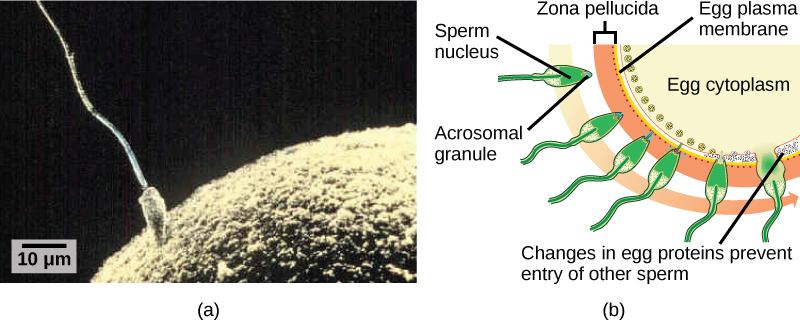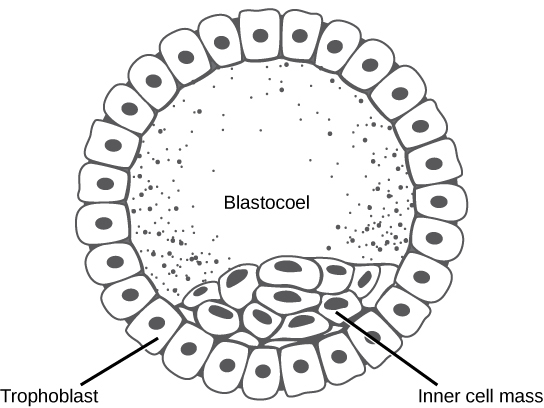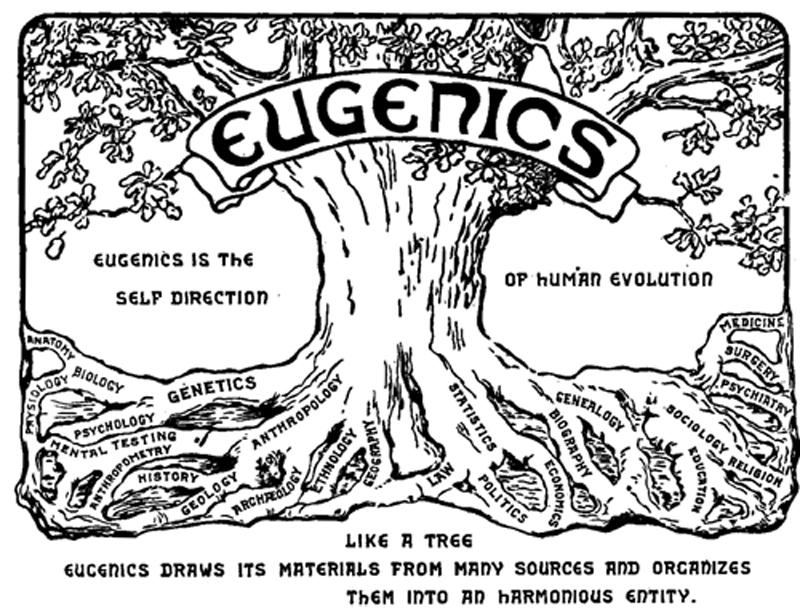Embryonic Induction Help a Ball of Cells Develop Into a Baby
Chapter 24. Animal Reproduction and Evolution
24.6. Fertilization and Early Embryonic Development
Learning Objectives
Past the end of this section, you will exist able to:
- Hash out how fertilization occurs
- Explain how the embryo forms from the zygote
- Discuss the part of cleavage and gastrulation in creature evolution
The process in which an organism develops from a single-celled zygote to a multi-cellular organism is complex and well-regulated. The early on stages of embryonic development are also crucial for ensuring the fitness of the organism.
Fertilization
Fertilization, pictured in Effigy 24.23 a is the process in which gametes (an egg and sperm) fuse to class a zygote. The egg and sperm each contain one set of chromosomes. To ensure that the offspring has only one consummate diploid prepare of chromosomes, only one sperm must fuse with 1 egg. In mammals, the egg is protected by a layer of extracellular matrix consisting mainly of glycoproteins called the zona pellucida. When a sperm binds to the zona pellucida, a series of biochemical events, chosen the acrosomal reactions, accept identify. In placental mammals, the acrosome contains digestive enzymes that initiate the degradation of the glycoprotein matrix protecting the egg and allowing the sperm plasma membrane to fuse with the egg plasma membrane, equally illustrated in Figure 24.23 b . The fusion of these two membranes creates an opening through which the sperm nucleus is transferred into the ovum. The nuclear membranes of the egg and sperm break down and the two haploid genomes condense to form a diploid genome.

To ensure that no more than than 1 sperm fertilizes the egg, once the acrosomal reactions take place at one location of the egg membrane, the egg releases proteins in other locations to forbid other sperm from fusing with the egg. If this machinery fails, multiple sperm can fuse with the egg, resulting in polyspermy. The resulting embryo is non genetically viable and dies within a few days.
Cleavage and Blastula Stage
The development of multi-cellular organisms begins from a single-celled zygote, which undergoes rapid cell division to form the blastula. The rapid, multiple rounds of cell partition are termed cleavage. Cleavage is illustrated in (Figure 24.24 a ). After the cleavage has produced over 100 cells, the embryo is chosen a blastula. The blastula is usually a spherical layer of cells (the blastoderm) surrounding a fluid-filled or yolk-filled cavity (the blastocoel). Mammals at this stage class a structure called the blastocyst, characterized by an inner jail cell mass that is distinct from the surrounding blastula, shown in Figure 24.24 b . During cleavage, the cells dissever without an increase in mass; that is, one large unmarried-celled zygote divides into multiple smaller cells. Each cell within the blastula is called a blastomere.

Cleavage can take place in two ways: holoblastic (full) cleavage or meroblastic (partial) cleavage. The blazon of cleavage depends on the corporeality of yolk in the eggs. In placental mammals (including humans) where nourishment is provided past the female parent's body, the eggs accept a very small corporeality of yolk and undergo holoblastic cleavage. Other species, such every bit birds, with a lot of yolk in the egg to nourish the embryo during development, undergo meroblastic cleavage.
In mammals, the blastula forms the blastocyst in the next stage of development. Here the cells in the blastula arrange themselves in 2 layers: the inner cell mass, and an outer layer called the trophoblast. The inner cell mass is also known as the embryoblast and this mass of cells volition proceed to form the embryo. At this stage of evolution, illustrated in Figure 24.25 the inner cell mass consists of embryonic stem cells that will differentiate into the unlike cell types needed by the organism. The trophoblast will contribute to the placenta and nourish the embryo.

Concept in Activeness

Visit the Virtual Human Embryo project at the Endowment for Human Development site to step through an interactive that shows the stages of embryo development, including micrographs and rotating 3-D images.
Gastrulation
The typical blastula is a brawl of cells. The next stage in embryonic development is the germination of the body plan. The cells in the blastula rearrange themselves spatially to form iii layers of cells. This procedure is called gastrulation. During gastrulation, the blastula folds upon itself to form the three layers of cells. Each of these layers is called a germ layer and each germ layer differentiates into different organ systems.
The iii germs layers, shown in Figure 24.26, are the endoderm, the ectoderm, and the mesoderm. The ectoderm gives rise to the nervous system and the epidermis. The mesoderm gives rise to the muscle cells and connective tissue in the trunk. The endoderm gives rise to columnar cells found in the digestive system and many internal organs.

Are Designer Babies in Our Future?

If you could prevent your child from getting a devastating genetic disease, would you practise it? Would you select the sex of your child or select for their attractiveness, strength, or intelligence? How far would y'all go to maximize the possibility of resistance to disease? The genetic engineering of a human child, the production of "designer babies" with desirable phenotypic characteristics, was one time a topic restricted to scientific discipline fiction. This is the example no longer: science fiction is now overlapping into science fact. Many phenotypic choices for offspring are already available, with many more likely to be possible in the non likewise afar futurity. Which traits should be selected and how they should be selected are topics of much debate within the worldwide medical community. The ethical and moral line is non always clear or agreed upon, and some fear that modern reproductive technologies could lead to a new grade of eugenics.
Eugenics is the use of data and technology from a variety of sources to improve the genetic makeup of the man race. The goal of creating genetically superior humans was quite prevalent (although controversial) in several countries during the early twentythursday century, but fell into disrepute when Nazi Germany adult an extensive eugenics plan in the 1930's and 40's. As part of their plan, the Nazis forcibly sterilized hundreds of thousands of the so-called "unfit" and killed tens of thousands of institutionally disabled people as function of a systematic programme to develop a genetically superior race of Germans known equally Aryans. Ever since, eugenic ideas have not been as publicly expressed, but there are still those who promote them.
Efforts have been made in the by to command traits in human children using donated sperm from men with desired traits. In fact, eugenicist Robert Klark Graham established a sperm bank in 1980 that included samples exclusively from donors with high IQs. The "genius" sperm banking company failed to capture the public'due south imagination and the operation closed in 1999.
In more recent times, the procedure known equally prenatal genetic diagnosis (PGD) has been developed. PGD involves the screening of human embryos as part of the process of in vitro fertilization, during which embryos are conceived and grown exterior the mother's body for some period of time before they are implanted. The term PGD usually refers to both the diagnosis, selection, and the implantation of the selected embryos.
In the least controversial use of PGD, embryos are tested for the presence of alleles which cause genetic diseases such as sickle prison cell disease, muscular dystrophy, and hemophilia, in which a single illness-causing allele or pair of alleles has been identified. By excluding embryos containing these alleles from implantation into the mother, the affliction is prevented, and the unused embryos are either donated to science or discarded. At that place are relatively few in the worldwide medical customs that question the ethics of this type of process, which allows individuals scared to have children because of the alleles they carry to do and so successfully. The major limitation to this procedure is its expense. Not commonly covered by medical insurance and thus out of reach financially for most couples, only a very pocket-size percentage of all live births use such complicated methodologies. Nevertheless, fifty-fifty in cases like these where the ethical issues may seem to be clear-cut, not everyone agrees with the morality of these types of procedures. For instance, to those who accept the position that homo life begins at formulation, the discarding of unused embryos, a necessary outcome of PGD, is unacceptable under any circumstances.
A murkier ethical situation is found in the selection of a child's sex, which is hands performed by PGD. Currently, countries such equally Great Uk have banned the choice of a child's sexual activity for reasons other than preventing sex-linked diseases. Other countries permit the process for "family unit balancing", based on the desire of some parents to have at least i child of each sex. Still others, including the Usa, have taken a scattershot approach to regulating these practices, essentially leaving it to the individual practicing physician to decide which practices are acceptable and which are not.
Even murkier are rare instances of disabled parents, such as those with deafness or dwarfism, who select embryos via PGD to ensure that they share their disability. These parents ordinarily cite many positive aspects of their disabilities and associated civilization as reasons for their choice, which they see as their moral right. To others, to purposely cause a disability in a kid violates the basic medical principle of Primum not nocere, "first, do no harm." This procedure, although not illegal in most countries, demonstrates the complexity of ethical problems associated with choosing genetic traits in offspring.
Where could this process atomic number 82? Will this technology go more affordable and how should it be used? With the ability of technology to progress quickly and unpredictably, a lack of definitive guidelines for the utilize of reproductive technologies before they arise might get in difficult for legislators to go on pace one time they are in fact realized, assuming the process needs whatever regime regulation at all. Other bioethicists contend that we should but deal with technologies that be now, and not in some uncertain future. They argue that these types of procedures will e'er be expensive and rare, so the fears of eugenics and "primary" races are unfounded and overstated. The debate continues.
Summary
The early on stages of embryonic development brainstorm with fertilization. The process of fertilization is tightly controlled to ensure that but ane sperm fuses with one egg. After fertilization, the zygote undergoes cleavage to form the blastula. The blastula, which in some species is a hollow ball of cells, undergoes a process called gastrulation, in which the 3 germ layers form. The ectoderm gives rise to the nervous arrangement and the epidermal skin cells, the mesoderm gives rise to the muscle cells and connective tissue in the body, and the endoderm gives rise to columnar cells and internal organs.
Exercises
- Which of the following is fake?
- The endoderm, mesoderm, ectoderm are germ layers.
- The trophoblast is a germ layer.
- The inner cell mass is a source of embryonic stem cells.
- The blastula is oftentimes a hollow brawl of cells.
- During cleavage, the mass of cells:
- increases
- decreases
- doubles with every cell partitioning
- does not alter significantly
- What do y'all think would happen if multiple sperm fused with one egg?
- Why do mammalian eggs have a small concentration of yolk, while bird and reptile eggs have a large concentration of yolk?
Answers
- B
- D
- Multiple sperm can fuse with the egg, resulting in polyspermy. The resulting embryo is not genetically viable and dies within a few days.
- Mammalian eggs do non need a lot of yolk because the developing fetus obtains nutrients from the mother. Other species, in which the fetus develops outside of the mother's torso, such equally occurs with birds, require a lot of yolk in the egg to nourish the embryo during evolution.
Glossary
acrosomal reaction
series of biochemical reactions that the sperm uses to break through the zona pellucida
blastocyst
structure formed when cells in the mammalian blastula separate into an inner and outer layer
gastrulation
procedure in which the blastula folds over itself to class the three germ layers
holoblastic
complete cleavage; takes place in cells with a small amount of yolk
inner prison cell mass
inner layer of cells in the blastocyst
meroblastic
partial cleavage; takes place in cells with a big amount of yolk
polyspermy
condition in which one egg is fertilized by multiple sperm
trophoblast
outer layer of cells in the blastocyst
zona pellucida
protective layer of glycoproteins on the mammalian egg
Source: https://opentextbc.ca/biology/chapter/24-6-fertilization-and-early-embryonic-development/
0 Response to "Embryonic Induction Help a Ball of Cells Develop Into a Baby"
Post a Comment